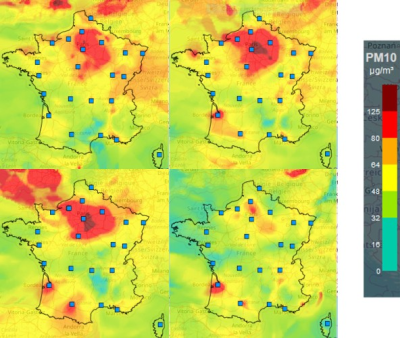室外空气污染:了解、告知和预防的关键

室外空气质量是当前社会面临的一大挑战。本文旨在阐明空气污染事件所涉及的现象,并描述其对健康造成影响和对经济带来的冲击。对室外空气质量的关注促使国家当局和欧盟提供空气质量监测和预报服务,如Prev’air和哥白尼大气区域系统。
根据世界卫生组织和法国公共卫生部的最新数据,2012年,室外和室内空气污染的综合影响导致全球650万人和欧洲60万人过早死亡[1]。环境空气污染是一个古老的现象,是人类集中在城市地区造成的结果(阅读大气污染),如今,它已成为公共卫生和环境面临的一大挑战(见图1)。

1996年12月30日的《空气与合理使用能源法》将空气污染定义为“人类直接或间接地将有害物质引入大气和封闭空间,这些物质可能危及人类健康、损害生物资源和生态系统、影响气候变化、破坏物质财产并散发恶臭”。
污染物排放源可以是人为的,也可以来源于自然。在天气条件的作用下,这些污染物在大气中会产生复杂的现象,从而导致空气质量下降。本文通过实例介绍并说明了有利于污染物的聚集或有利于污染物在大气中稀释或扩散的气象条件。悬浮颗粒物或活性气体对人体的有害影响已成为众多研究的主题。根据这些研究结果,需要实施法规,监测主要污染物的阈值超标情况,为公众和决策者提供参考。为了更好地了解和预测产生污染的因素,数值模拟是运行预警和决策支持系统的重要工具之一。
1.天气条件——影响大气污染物浓度的一个重要因素
“大气”是指地球周围受重力影响的所有气体。地球的大气层和气体包络层一文描述了大气的组成及其物理和化学特征。污染现象涉及大气的前两层,即对流层(海拔在12公里以下,视纬度而定)和平流层(高达60公里)。影响平流层的污染主要表现为额外的温室效应(参见大气污染),以及特殊天气条件和人类活动产生的卤代化合物(氯氟化合物或氟氯化合物)对保护性臭氧层造成的破坏。
1.1大气边界层
在不同的天气条件下,污染物浓度变化最大的是对流层,特别是大气边界层。这一边界层是大气中受地球表面影响的部分,其厚度从几百米到几公里不等,取决于较大尺度的大气条件和地表特征[2]。地面摩擦力和温度的昼夜变化对气流和温度有影响。
与人类活动有关的主要污染物(氮氧化物、硫氧化物、碳氢化合物和细颗粒物)或自然污染物(沙尘、海雾、植被等释放的挥发性有机化合物) 也是在大气边界层释放的。污染物的来源和形成在空气污染一文中有所描述。污染物被排放到大气后,会根据天气状况扩散或积聚(见图2),在下述条件的影响下,污染物会被迅速迁移、稀释、溶解和沥滤:
风的影响。在风力作用下,污染物横向漂移长达几百公里。风速越高,污染物在排放源附近的累积量就越少。
垂直湍流的影响。在边界层内出现垂直湍流有两个原因:一是由于下地表加热引起的热力效应,二是受地面障碍物引起的水平和垂直风切变的影响引起的机械效应。这种湍流还有利于与地面、植被和遇到的各种障碍物接触的污染物的稀释和干沉降。
温度的影响。温度直接影响污染物之间的化学反应速度,从而影响污染物转化为二次污染物。
降水(雨、雪、雾)的影响。有些气态污染物可溶于水,会溶解在雾滴或云层中。这种现象被称为湿沉降。在云中,气溶胶颗粒可以作为云滴的凝结核,促使云滴形成。降水会将空气中的颗粒物冲刷下来。就颗粒而言,则称为云相中的气溶胶捕获。至于降雨,则会导致颗粒和气体从云层中渗出。

因此,气象条件影响了大气边界层的稳定性。
因此,在白天晴朗的天空中,地面温度高于地表空气温度时,随着地面升温,不稳定大气层厚度增加。这种不稳定性使得污染物在周围空气中被稀释。然而,到了晚上,地表会因辐射而降温。这时,我们会观察到几百米范围内的逆温现象。在这一层中,空气的稳定性会影响污染物的扩散。
1.2冬季污染
逆温现象在冬季微风的反气旋条件下尤为明显。由于白天的太阳辐射较弱,持续时间较短,这个季节的温度逆温会持续数小时。
由人类活动(交通、区域供暖、工业设施等)产生的污染物排放(二氧化氮、 二氧化硫、细颗粒物)会滞留在大气低层并积聚在次。此外,与这些寒冷事件有关的供暖增加了颗粒物排放。只有天气条件发生变化、扰动来临、风力加强或风向改变,才能通过污染物的垂直扩散来结束污染物的滞留现象。
最后,特殊情况(山谷效应、地形起伏、海风或城市热岛)也可能通过有害化学元素的积累而导致污染现象。法国阿尔沃河谷冬季经常出现颗粒物污染就是一个例证。主要原因是在寒流期间大量使用木材供暖,以及地形造成的封闭性,促使细小的碳质颗粒在近地面的薄稳定层中累积。

[图片来源:© Prev’air]
2016年12月初巴黎严重的细颗粒物污染事件说明了这一现象。当时气温偏低,天气状况属于“稳定反气旋”类型,低层逆温(12月1日法兰西岛低于200米),北半部大面积地区风力较小。这些条件有利于增加供暖引起的本地排放,并限制了城市(供热、道路交通)和工业源排放的污染物在大气中的扩散。
在巴黎地区,巴黎大区空气质量监测协会(AIRPARIF)测得的PM10最高浓度在12月1日为146微克/立方米,12月2日为122微克/立方米。这样的浓度水平在过去十年最重要的冬季天气事件中名列前茅。随着一股东风的到来,情况得以缓解:风力虽小,但风向稳定,累积现象有限。
1.3夏季污染
夏季,在无风且太阳辐射最强的情况下,污染物如氮氧化物(NOx)、挥发性有机化合物(VOCs)(包括碳氢化合物、甲烷和一氧化碳)的累积,会导致大气低层产生臭氧。因此,几乎每年夏天,大城市的光化学污染都会达到峰值。
当风携带气团时,污染就会发生在前体污染源的下风向。事实上,二氧化氮形成臭氧的化学反应是可逆的,并且发生在一氧化氮大量排放的地方(如道路)。臭氧可与二氧化氮分解过程中形成的一氧化氮发生反应,生成二氧化氮。因此,有时在大城市附近的城郊地区或农村地区观察到的臭氧浓度高于城市的中心地区。
这是一种城市臭氧烟羽现象。在城市污染物排放的上游,氧化剂浓度(总体为Ox,Ox=O3+NO2)与本底水平相对应。在城市的下风向,低氮氧化物排放量不再允许臭氧发生化学还原反应,臭氧恢复到其背景值,随着上风向产生的数量和风的携带而增加。
生物排放的挥发性有机物。夏季,植物也会释放挥发性有机物,尤其是在强烈阳光和高温的影响下。植被释放的挥发性有机物主要是异戊二烯(C5H8),主要来自落叶树木,针叶树则可释放出更复杂的萜烯化合物。挥发性有机物在大气化学中发挥着重要作用,并促进了臭氧和次级有机气溶胶等二次污染物的形成。在全球范围内,植被排放了约90%的挥发性有机化合物,而人类活动排放的挥发性有机化合物仅占10%[3]。
最后,我们不能局限于局地尺度来考虑严重污染事件:大尺度运输解释了污染物横向扩散到几百公里之外的原因。城市臭氧污染事件与气团输送密切相关。要量化这些现象,必须考虑到城市、区域和国家之间的相互作用。
2.健康影响和经济成本
大量的研究(例如巴黎第七大学细胞生理学和细胞毒理学实验室进行的研究[4])表明,高比例的暴露人群使城市和室内污染成为一个重大的公共健康问题。毒理学研究和流行病学方法确定了短期影响和长期影响。前者表现为接触后几分钟至几周内出现的临床表现,后者表现为长期接触后数月或数年内出现的临床表现。这些影响导致相关人口的死亡率上升或预期寿命缩短。
尽管人们很早就认识到空气污染物对人类健康的危害,但人们真正开始关注这一问题是在1952年12月伦敦发生了严重污染事件,造成4000多人死亡之后(参见大气污染)。
为确定污染物对健康的影响而进行的毒理学研究包括在实验室中对细胞培养物进行实验,以及让动物或人体接触已知和受控数量的污染物。此外,流行病学方法通过统计工具,将对某些污染物的测量结果与在受污染人群中观察到的病症联系起来。事实上,只有对大量受试者进行长期监测,才有可能将健康数据(病理、住院、死亡等)与各种污染物的测量结果进行比较。
2.1病理学

[图片来源:©马里昂·皮顿和西尔维·吉多蒂]
这些不同的方法一致认为,气体成分或颗粒物的高度氧化性和刺激性会导致肺部疾病(哮喘、呼吸系统疾病)、心血管疾病(心律失常、心肌缺血)、神经系统疾病和某些癌症。
气态污染物能否进入呼吸道取决于其溶解度。臭氧(O3)或二氧化氮(NO2)等污染物具有高度氧化性,因此刺激性很强。至于颗粒物,它们在呼吸道中的沉积取决于其大小。颗粒物越小,进入肺部越深,沉积在支气管甚至细支气管中,导致哮喘、细支气管炎、肺部疾病和心血管疾病恶化(见图5)。
这些不同研究强调了慢性污染在导致疾病中的重要作用,低于该阈值接触污染物不会对健康造成危害。因为灵敏度阈值在个体之间存在差异。不应仅关注严重污染事件,还应广泛采取措施减少本底污染。
2.2几个数字
世界卫生组织(WHO)在其报告中区分了环境空气污染的影响和室内空气污染的影响,同时认识到两者的综合影响以及准确识别两种影响的难度[5]。下文将只报告环境空气污染的影响。
使用新模型评估细颗粒物(PM2.5)的暴露情况,并结合风险评估方法,估计全世界每年有300多万人因室外空气污染而死亡,证实这些死亡大多发生在低收入国家[6]。
2011年,一项为期三年的欧洲研究APHEKOM[7],采用传统的健康影响评估方法,估算了城市污染对参与该项目的25个欧洲主要城市居民健康的影响。该研究估算了如果按照世界卫生组织的建议,将细颗粒物(PM2.5)的平均水平降低到10微克/立方米,30岁人群平均预期寿命增加的月数。据估计,欧洲每年与大气污染有关的健康费用和相关费用(缺勤、质量损失和预期寿命)达305亿欧元。
研究结果还将某些慢性病的发生与居住在主干道附近的居民联系起来。15-20%的儿童哮喘发作和65岁以上成年人慢性阻塞性肺病的恶化可能与污染有关。
最后,法国公共卫生部[8]发布了一份报告,该报告介绍了2007年和2008年对长期接触细颗粒物(PM2.5)与死亡率之间的联系所做的最新定量健康影响评估(QISA)。这项研究表明,法国每年有超过48,000人死于人为颗粒物造成的污染。各地区的研究结果以地图的形式提供。为量化污染对臭氧的影响,也进行了此类研究。报告还回顾了这些评估的不确定性,上游的不确定性涉及人口的排放和暴露的量化、所观察到的病理原因(与生活方式、饮食、吸烟、工作场所接触等有关的混杂因素……)以及所使用的方法选择。尽管存在局限性,但研究结果提高了人们对健康问题紧迫性的认识,使人们认识到有必要采取措施以减少空气污染。
3.国家和欧盟层面的公共信息——Prev’air系统和哥白尼大气监测服务系统
正如玛丽安·莫利纳-杜博斯特的文章所述(参见法律如何保护空气质量?),1996年颁布的《空气法》深刻地改变了国家机构对空气相关问题的看法。这是建立空气质量监测机构网络(AASQA)的起点。在2000年代,随着以模型为导向的Prev’air系统的创建,这一系统得以完善。
3.1 Prev’air系统
该平台用于预测主要受管制污染物的浓度,由法国国家工业环境与风险研究院(INERIS)负责日常管理。该系统于2004年由INERIS、法国气象局、法国国家科学研究中心和空气质量监测中心实验室(LCSQA)联合开发。今天,该联盟仍在继续开发这一欧洲独一无二的系统。

[图片来源:© Prev’air]
Prev’air[9]旨在定期提供有关法国和欧洲未来三天主要受管制污染物浓度的可靠信息,并让更多人了解这些数据。为了进行预测,使用了两个被称为“化学-输运”的数值模型:由INERIS和皮埃尔-西蒙·拉普拉斯研究所共同开发的CHIMERE模型,以及由法国气象局开发的MOCAGE模型。
这些预测污染物浓度的运行模型需要以下信息:
排放清单,是静态的(不依赖于天气状况),详细记录了一段时间内排放量的时空分布。排放包括人类活动产生的排放(人为排放),也包括自然来源(植被、土壤等)产生的排放。考虑到土地使用的变化,这些排放清单会定期更新。依据不同情况(天气条件、一年中的时间点、公共假期等),排放清单会发生动态变化。值得一提的是,清单开发工作是MACC和MACCII研究项目的一部分。该研究项目是哥白尼项目的前身。
天气条件,如第一部分所示,天气条件为污染事件创造了有利条件,也是污染事件结束的主要因素。因此,天气预报会影响空气质量预测的精度。这一点在很大程度上解释了不同信息来源对污染物浓度(或扩展的空气质量)预测的差异。
边界条件。实际上是考虑了区域边界的化学成分状态。这些污染物可能会在建模区域内相互作用或移动(例如传输效应)。

[图片来源:© 哥白尼大气监测服务系统]
Prav’air系统生成的数据可由获批的空气质量机构重新利用,以生成适合其领域的更精细的预报,或以制图形式显示,从而在所考虑的时空尺度内监测污染事件的演变。
该系统是欧洲的先驱,会定期对其重新评估[10],并不断发展以考虑更多的化学现象,提高现场分辨率,纠正预报中观测到的偏差。化学和空气质量建模领域的研究工作有助于丰富这项面对用户的服务。因此,2005年Primequal呼吁启动项目研究空气质量与农业之间的联系。还应指出的是,2004年推出了空气质量模型,通过对二次气溶胶进行建模,将化学反应考虑在内,进一步对其进行了完善。
3.2欧洲哥白尼大气监测服务系统
欧洲采用了另一种方法。在监测大气成分和气候研究项目(MACC)的建立,2009年开发一个无以伦比的空气质量监测和预报系统。该系统涉及由不同欧洲团队开发和实施的一组模型,大约有十个。汇集了35个欧洲合作伙伴、国家气象部门和其他研究组织,包括法国气象局和INERIS[11]。2015年,设立了哥白尼大气监测服务系统[12]。
这些服务的业务实施已由欧盟委托给主要运营商。大气监测部分的运营商是欧洲中期天气预报中心(ECMWF/ECMMT)。在该中心的支持下,法国气象局和INERIS协调欧洲的空气质量预报和分析服务以及空气质量管理战略评估服务。
自2015年以来,欧洲环境网站www.regional.atmosphere.copernicus.eu提供了未来4天10种污染物(包括授粉季节的花粉物种)浓度的预报、前一天的分析(利用欧洲环境署收集的定点观测数据修订预报)或年度再分析,从而可以评估和监测趋势,进而评估和监测公共政策的影响。这些数据提供可视化和下载服务,遵守标准化数据交换协议(包括WMS/WCS服务)。下载服务完全免费,供下游专家系统使用。通过提供分辨率更高的空气质量信息,将这些数据与其他数据源交互参照,统计处理以提升输出质量。
在MACC先驱项目结论的基础上,保留了多模型方法,CAMS区域预报由欧洲七个最佳模型的输出结果组合而成,所有模型均能达到预期的服务水平。这些模型由国家气象服务机构或组织(来自芬兰、法国、挪威、瑞典、荷兰和英国)及大学实验室(如丹麦奥尔胡斯大学、德国科隆大学莱茵环境研究所、波兰华沙工业大学)制作。该系统生产的旗舰预报产品被称为集成预报,是各个预报结果的中位数。得益于每个模型的优点,可以提供0.1°分辨率的欧洲空气质量预报。

[图片来源:© 马里昂·皮顿和西尔维·吉多蒂,哥白尼大气监测服务系统]
请注意,每个单独的模型都使用相同的输入数据、ECMWF天气预报数据、排放数据和其他哥白尼大气服务产生的边界条件。这增强了系统的稳健性,可以对模型的内在不确定性加以分析和考量。
该系统作为全球系统的补充[13],目前正处于扩展阶段,会继续提供新的服务(新的花粉品种、新的再分析),并在欧盟层面对其发展情况进行控制和监测,包括提供大规模数据下载平台并辅以服务的项目。这可以通过更新排放清单或提供创新服务,如基于卫星数据同化的火灾监测系统来实现。火灾监测系统应纳入区域空气质量预报系统;因此,欧洲以外的火灾对欧洲空气质量的影响可应纳入预报之中。
Prev’air系统和哥白尼大气监测服务系统是两个不同地理尺度的建模系统,两个模型之间的交互作用。这项欧洲天气服务系统也可以为国家层面的空气质量监测提供支持。最后,使用“哨兵”卫星数据还将有助于实施新产品和改进现有产品。
参考资料和说明
封面照片:新德里的空气污染(烟雾)。图片来源:Flickr-License:CC BY-NC]
[1] 世卫组织2016年11月报告“2012 年家庭和环境空气污染联合影响造成的疾病负担”[http://www.who.int/airpollution/data/AP_jointeffect_BoD_results_Nov2016.pdf]
[2] Malardel S. (2009). Fundamentals of Meteorology, Cepadues-Editions
[3] Fuentes et al (2000). Biogenic Hydrocarbons in the Atmospheric Boundary Layer: A Review Bulletin of the American Meteorological Society 81:7, 1537-1575
[4] Auger F. (2006). Involvement of fine atmospheric particles (PM<2.5μm)in the induction of cardiovascular diseases. In vitro study of the relationships between the epithelium of the respiratory tract and the cells of the vascular endothelium. Thesis University Paris 7.
[5] 世卫组织(2016年11月)。2012年家庭和环境空气污染共同影响的疾病负担。[http://www.who.int/phe/health_topics/outdoorair/databases/AP_jointeffect_BoD_results_Nov2016.pdf?ua=1]
[6] 世卫组织(新闻稿,2016年9月27日)。世卫组织发布了国家对空气污染暴露和健康影响的估计。[http://www.who.int/mediacentre/news/releases/2016/air-pollution-estimates/fr/]
[7] Aphekom项目。改善欧洲空气污染和健康决策的知识与交流。[http://aphekom.org/web/aphekom.org/home]
[8] href=”http://opac.invs.sante.fr/doc_num.php?explnum_id=10431″>法国公共卫生。法国大陆长期接触细颗粒物对死亡率的影响和若干空气污染减少情景带来的健康收益分析。
[10] Rouil L., Honore C., Vautard R., Beekmann M., Bessagnet B., Malherbe L., Meleux F., Dufour A., Elichegaray C., Flaud J-M., Menut L., Martin D, Peuch A., Peuch V-H., Poisson N., 2009, PREV’AIR : an operational forecasting and mapping system for air quality in Europe, BAMS, DOI: 10.1175/2008BAMS2390.1
[11] Marécal V., Peuch V.-H., Andersson C., Andersson S., Arteta J., Beekmann M., Benedictow A., Bergstrom R., Bessagnet B., Cansado A., Cheroux F., Colette A., Coman A., Curier R. L.,. Denier van der Gon H. A. A. C, Drouin A., Elbern H., Emili E.,. Engelen R. J.,. Eskes H. J., Foret G., Friese E., Gauss M., Giannaros C., Joly M., Jaumouillé E., Josse B., Kadygrov N., Kaiser J. W., Krajsek K., Kuenen J., Kumar U., Liora N.,. Lopez E., Malherbe L., Martinez I., Melas D., Meleux F., Menut L., Moinat P., Morales T., Parmentier J., Piacentini A., Plu M., Poupkou A., Queguiner S., Robertson L., Rouil L., Schaap M., Segers A., Sofiev M., Thomas M., Timmermans R., Valdebenito A., van Velthoven P., van Versendaal R., Vira J., and Ung A., A regional air quality forecasting system over Europe: the MACC-II daily ensemble production, Geosci. Model Dev. Discuss, 8, 2739-2806, 2015, doi:10.5194/gmdd-8-2739-2015
[13] http://atmosphere.copernicus.eu/
环境百科全书由环境和能源百科全书协会出版 (www.a3e.fr),该协会与格勒诺布尔阿尔卑斯大学和格勒诺布尔INP有合同关系,并由法国科学院赞助。
引用这篇文章: GUIDOTTI Sylvie, PITHON Marion (2024年3月13日), 室外空气污染:了解、告知和预防的关键, 环境百科全书,咨询于 2025年4月4日 [在线ISSN 2555-0950]网址: https://www.encyclopedie-environnement.org/zh/air-zh/outdoor-air-pollution-understanding-to-inform-and-prevent/.
环境百科全书中的文章是根据知识共享BY-NC-SA许可条款提供的,该许可授权复制的条件是:引用来源,不作商业使用,共享相同的初始条件,并且在每次重复使用或分发时复制知识共享BY-NC-SA许可声明。









